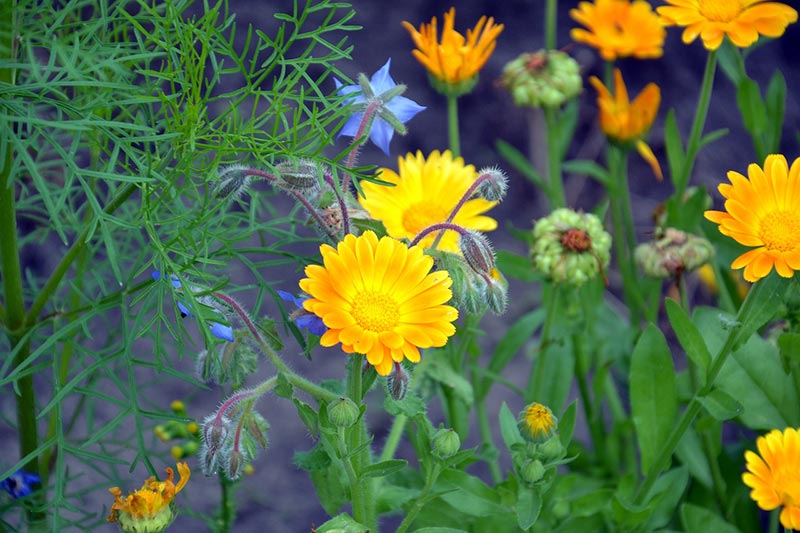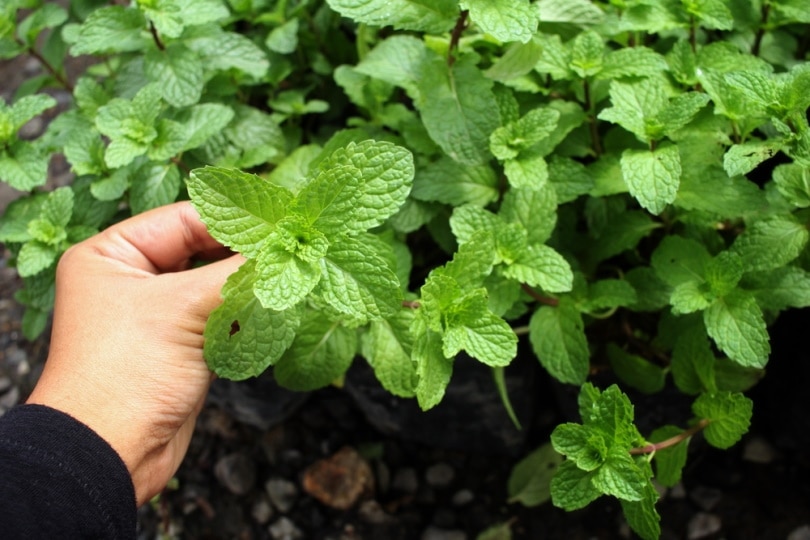5 Companion Plants for Oregano (With Pictures)
-
Pete Ortiz
- Last updated:

The companion planting technique is an age-old practice that has been utilized by gardeners and farmers for centuries. This method involves the strategic placement of different plants to create a beneficial environment for one or more species.
These plants are known as “companion” because they grow best when planted together – not necessarily because they like to hang out with each other on the weekends. The benefits of companion planting extend beyond simply protecting plants from pests. These five awesome companion plants for oregano not only help keep harmful insects at bay, but also increase the production of oregano in your garden or home greenhouse.
The 5 Companion Plants for Oregano
Oregano is an excellent herb to grow in your garden or greenhouse, but it’s not a flower that’s completely self-sustaining. Most oreganos are perennials, which means that they require some maintenance to stay healthy. There are a few companion herbs that will help oregano flourish and become more productive in your garden.
1. Calendula

Calendula is an excellent way to attract pollinators into your garden. Calendula has a higher level of pollen than its cousin, marigold. This makes it more appealing to butterflies and bees. It will attract beneficial insects such as hoverfly and lacewing.
In addition to oregano, calendula grows alongside artichokes and mullein, cabbages, kale, broccoli, aronia, and many other plants! Calendula can also be used to trap aphids. Aphids love the sticky sap it excretes.
2. Dill

One of the best companion plants for oregano is dill. This herb is a great source of nectar for bees, so it is a wonderful choice for gardens that are meant for pollination. It also has a beautiful aroma that repels pests, especially mosquitoes. In addition, dill can help improve the soil’s structure, which is important for oregano’s root system.
Oregano and dill are both members of the mint family, which means they enjoy similar growing conditions. Dill’s growing conditions are best when the temperature stays between 65–75 degrees Fahrenheit. You can easily grow dill in your garden or indoor container garden.
3. Nasturtium

Nasturtium is a beautiful and fragrant flowering plant that is also a great companion for oregano. It repels many common plant pests, including and whiteflies. Nasturtium plants are completely edible and make a tasty addition to salads, sandwiches, and other side dishes. They taste slightly peppery and are often described as a mix between watercress and radishes. Nasturtium plants are easy to grow, even indoors.
4. Other Herbs

Since oregano is an herb that is often used for cooking, you can plant it with other cooking herbs as well. Many people plant oregano in an herb garden either indoors or outdoors with these other herbs, so it was easier to just list them all together. You can plant oregano with:
- Basil
- Marjoram
- Chives
- Parsley
- Rosemary
- Sage
- Thyme
5. Mint

Finally, other herbs in the mint family make great companion plants for oregano. However, when planting mint with oregano and other herbs, it’s best to give the mint its own pot and place the pot near the oregano. This is because mint is a vigorous grower and spreader and may overtake smaller herbs if planted in the same pot.
Why Are Companion Plants Important?
Companion planting has been practiced for centuries and is one of the best ways to optimize the ability of your garden. It can help you achieve higher crop yields while using fewer resources like water and fertilizer. There are several reasons why companion planting is such an important practice:
- Certain plants naturally repel pests and therefore can protect other plants that are less able to do so.
- Some plants are known to increase the overall health of other plants. This can include anything from improving growth to extending the length of time that a plant stays edible.
- They can naturally attract beneficial insects, which can be beneficial if you want to avoid using pesticides in your garden.
- In many cases, when planted together, they are known to increase soil health and fertility. This can help you use less fertilizer and have more successful crops in general.
- Some plants’ root systems can actually benefit each other, meaning you can have more plants in a smaller space.
The Bad News: Which Plants Are Not Good Companions for Your Oregano Plants?

And along with the good, also come the plants that aren’t great for your oregano. The main culprits are really tomatoes and potatoes. These three plants are in the same botanical family and therefore can negatively affect each other in a few ways, so it’s best to avoid planting them near one another or in the same shared space.
Tomatoes, potatoes, and oregano all belong to the same botanical family, which is the Solanaceae. They are therefore susceptible to some of the same pests and diseases. Oregano, like other members of the mint family, is toxic to tomato plants. Believe it or not, growing it with tomatoes can reduce the growth rate of oregano plants by as much as 50% compared to growing them in isolation. Oregano plants can actually cause plants that are planted near them to rot.
Why Plant Oregano at Home?
Many chefs and home gardeners prefer to plant and grow their own oregano. If you’re not familiar with oregano, it’s an herb that’s closely related to marjoram, basil, and thyme. It’s a perennial plant that grows in warm, sunny climates and is commonly used in Italian and Mediterranean dishes. You can use oregano in many different ways, from seasoning meat and fish to making sauces and soups.
It has a fragrant and slightly bitter taste, with a hint of citrus. While it’s not to everyone’s taste, many people love its flavor and use it often in cooking.

The Process of Growing Oregano from Seed
If you’re growing oregano from seed, you’ll want to start your plants indoors about 8-10 weeks before your last frost date. This will give your plants plenty of time to grow and thrive before the weather gets too cold to grow them outdoors. Start by choosing the best seeds.
You can find many different varieties of oregano seeds online, and some may be better for your climate than others. Make sure to do some research and find seeds that will do best in your climate and conditions. Once you’ve chosen your seeds, soak them in water for 24 hours to help them germinate.
After soaking, plant them about one-quarter inch below the surface of your soil and keep them well-watered until they sprout. Growing oregano from seed isn’t difficult, but it will take time. Patience is key to growing these plants indoors.
Where to Grow Your Oregano?
Oregano is a warm-weather plant that prefers full sun, great drainage, and lots of moisture. If you live in a cool or warm climate, you’ll need to grow it indoors, but if you live in a warm and sunny climate, you can grow it both indoors and outdoors. Growing oregano isn’t hard, but there are some things you should know regardless of whether you grow the plant indoors or outdoors.
For example, try to use a potting mix that contains plenty of peat moss or sandy loam. Most of these mediums are excellent for growing oregano as they can help with drainage and prevent soil compaction – something that can ruin your oregano crop. Also, make sure to add plenty of organic matter to your soil. This will help keep your plant healthy and prevent common plant diseases.

Tips for Growing Oregano Indoors
Oregano plants need lots of light to thrive, so you may want to consider growing it in a greenhouse or a sunny window.
If growing indoors, make sure to water your plants regularly, but don’t over-water them. Also, always be sure to water your plants when the soil is dry, but don’t allow the soil to become soggy or waterlogged (this can cause root rot). Lastly, be sure to fertilize your plants at least once every two weeks (yes, they require a lot of fertilizer), and make sure they have plenty of air circulation.
Tips for Growing Oregano Outdoors
Growing oregano outdoors is a great way to enjoy your herb all year round. As long as you live in a warm and sunny climate and have plenty of room in your garden, you can grow oregano outdoors. You can also grow it indoors by planting it in pots, as long as you keep it warm and well-lit.
To grow oregano outdoors, make sure to choose a sunny location near a source of water (though you can just water it with a pitcher) and plenty of organic matter (if possible). Also, make sure your soil is rich in nutrients and well-draining, and make sure to water your plants regularly. When harvesting your oregano, make sure to do so before the plant flowers. This will allow it to grow back more quickly and will keep it healthy and strong.
Wrapping Things Up
Oregano is an excellent herb to grow in your garden or greenhouse. However, it’s not a flower that’s completely self-sustaining. Companion planting is an effective way to increase oregano’s production and make it more resilient to pests. These five companion plants for oregano are easy to grow and make excellent additions to any garden. They also make delicious edible herbs that can be used in a variety of dishes.
- Companion Planting Herbs: Best Herbs to Plant Together | The Old Farmer’s Almanac
- How to Grow Oregano in Your Home Herb Garden – 2022 – MasterClass
- 10 Companion Herbs To Plant In Your Garden | 1 Million Women
- Dill: Planting, Growing, and Harvesting Dill Weed in the Garden | The Old Farmer’s Almanac
- Tips For Growing Wormwood Herb Plants.
- How to Grow Oregano Indoors
- How to Grow Oregano | Apartment Therapy
Featured Image Credit: HansLinde, Pixabay
Contents



